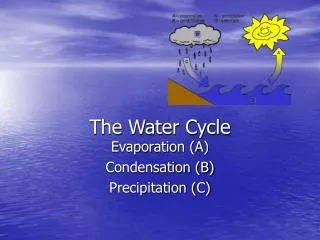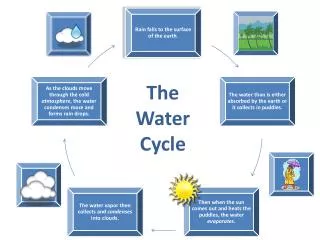The Water Cycle
The Water Cycle. The Water Cycle. Describes the movement of water on, in, and above the earth Water is always changing and moving from one place to another This cycle is made up of a few main parts: Precipitation Infiltration Runoff Transpiration Evaporation Water Vapor Condensation
Share Presentation
Embed Code
Link
Download Presentation
- water
- water vapor
- water cycle
- liquid water
- gas water vapor
- gas called water vapor

gema + Follow
Download Presentation
The Water Cycle
An Image/Link below is provided (as is) to download presentation Download Policy: Content on the Website is provided to you AS IS for your information and personal use and may not be sold / licensed / shared on other websites without getting consent from its author. Content is provided to you AS IS for your information and personal use only. Download presentation by click this link. While downloading, if for some reason you are not able to download a presentation, the publisher may have deleted the file from their server. During download, if you can't get a presentation, the file might be deleted by the publisher.
Presentation Transcript
- The Water Cycle
- The Water Cycle • Describes the movement of water on, in, and above the earth • Water is always changing and moving from one place to another • This cycle is made up of a few main parts: • Precipitation • Infiltration • Runoff • Transpiration • Evaporation • Water Vapor • Condensation • Collection
- What is the water cycle? • The repeating change of water on the Earth creates a cycle • As water goes through its cycle, it can be a solid (ice), a liquid (water), or a gas (water vapor) • Ice can change to become water or water vapor • Water can change to become ice or water vapor • Water vapor can change to become ice or water.
- Precipitation • Happens when the temperature and the atmospheric pressure are right • The small droplets of water in clouds form larger droplets and precipitation occurs. The raindrops fall to earth. • Occurs when so much water has condensed that the air cannot hold it anymore • The clouds get heavy and water falls back to the earth in the form of rain, hail, sleet or snow • Click the speaker below to hear rain falling
- Forms of Precipitation • Rain: Sleet: • Snow: Hail:
- Infiltration • Important process where • rain water soaks into the • ground, through the soil and underlying rock layers • The flow of water from the • ground surface into the ground • Once infiltrated, the water • becomes soil moisture or • groundwater
- Groundwater Flow • Movement of water underground is called groundwater flow • Groundwater slowly moves through the spaces and cracks between the soil particles on its journey to lower elevations
- Runoff • The movement of land water to the oceans, mainly in the form of rivers, lakes, and streams • Consists of precipitation that neither evaporates, transpires nor penetrates the surface to become groundwater • Excess runoff can lead to flooding, which occurs when there is too much precipitation
- Transpiration • Process that happens through plants • As plants absorb water from the soil, the water moves from the roots through the stems to the leaves • Once the water reaches the leaves, some of it evaporates from the leaves, adding to the amount of water vapor in the air.
- Evaporation • The process where a liquid, in this case water, changes from its liquid state to a gaseous state. • The sun heats up water in rivers or lakes or the ocean and turns it into vapor or steam. • The water vapor or steam then leaves the river, lake, or ocean and goes into the air.
- Water Vapor • Water in its gaseous state-instead of liquid or solid (ice) • Totally invisible • Extremely important to the weather and climate • Without out it, there would be no clouds or rain or snow • All of the water vapor that evaporates from the surface of the Earth eventually returns as precipitation - rain or snow
- Condensation • Formation of liquid drops from water vapor • Occurs when a parcel of rising air expands and cools • Responsible for the formation of clouds • These clouds may produce precipitation, which is the primary route for water to return to the Earth's surface within the water cycle
- Collection • When water falls back to earth as precipitation, it may fall back in the oceans, lakes or rivers or it may end up on land • When it ends up on land, it will either soak into the earth and become part of the “ground water” that plants and animals use to drink. • It may run over the soil and collect in the oceans, lakes or rivers where the cycle starts all over again.
- How Do These Changes Happen? • Adding or subtracting heat makes the cycle work. • If heat is added to ice, it melts. If heat is added to water, it evaporates. • Evaporation turns liquid water into a gas called water vapor. • If heat is taken away from water vapor, it condenses. • Condensation turns water vapor into a liquid. • If heat is taken away from liquid water, it freezes to become ice.
- Why the water cycle is important • Humans use water for drinking, respiration, perspiration, and elimination of wastes are all part of this cycle • Large amounts of water are needed for most economic activities: agriculture and mining, food processing, manufacturing • Lakes and rivers provide towns and cities with a means of discharging wastes
- Why the Water Cycle is Important… Continued • Generation of electricity from thermal power plants • Waterways provide transportation • Recreational activities • Some people view the rivers and large lakes of this country as a part of their own identity • AND MUCH MORE.
- Watch This Video To Learn More About The Water Cycle! Click the link below http://www.youtube.com/watch?v=_1oCoKj7b2o
- You can sing along! Click the link below to sing about the water cycle. http://www.teachertube.com/view_video.php?viewkey=53bdf2518c53ddf3bce6
- The Summary of the Hydrologic Cycle • The water cycle is called the hydrologic cycle. In the hydrologic cycle, water from oceans, lakes, swamps, rivers, plants, and even you, can turn into water vapor. • Water vapor condenses into millions of tiny droplets that form clouds. • Clouds lose their water as rain or snow, which is called precipitation. • Precipitation is either absorbed into the ground or runs off into rivers. • Water that was absorbed into the ground is taken up by plants. • Plants lose water from their surfaces as vapor back into the atmosphere. • Water that runs off into rivers flows into ponds, lakes, or oceans where it evaporates back into the atmosphere. • The cycle continues.
- Now it’s your turn! Lets label the Water Cycle together! Condensation Evaporation Precipitation Runoff Infiltration Groundwater flow
- Bibliography • The Water Cycle. Enchanted Learning. 1999-2008. http://www.enchantedlearning.com/subjects/astronomy/planets/earth/watercycle.shtml • Water Cycle. Wikipedia. 2008. http://en.wkipedia.org/wiki/water_cycle • The Water Cycle. DLTK’s Sights. 1998-2007. http://www.kidzone.ws/water/ • You Tube. http://www.youtube.com/

The Water Cycle
The Water Cycle. Evaporation (A) Condensation (B) Precipitation (C). How old is your water?. The water in your glass may have fallen from the sky as rain just last week, but the water itself has been around pretty much as long as the earth has!
532 views • 11 slides

The Water Cycle
The Water Cycle. Or The Hydrologic Cycle.
599 views • 42 slides

The Water Cycle
The Water Cycle. Water Cycle. Evaporation is the process in which water changes from liquid to vapor. Condensation is the process in which water vapor in the atmosphere becomes liquid. Precipitation is the water that falls from clouds.
399 views • 8 slides

The water cycle
The water cycle. By: Polly couch , Sarah Roark , And Kara pace. . What is the water cycle?.
328 views • 9 slides

The Water Cycle
The Water Cycle. Water cycles between the oceans, atmosphere and land. All living organisms require water . A. Water enters the atmosphere as water vapor , a gas, when water evaporates from the ocean or other bodies of water.
389 views • 8 slides

The Water Cycle
The Water Cycle. Vocabulary. All images courtesy of Microsoft Clip Art and Google Images under Creative Common Licensing. Evaporation. t he energy from the Sun heats up the water bodies on Earth This causes water to evaporate from the surface of these water bodies. .
396 views • 10 slides

The Water Cycle
The Water Cycle. Precipitation, Evaporation, Transpiration, Condensation. Vocabulary. atmosphere hydrosphere precipitation evaporation Transpiration – process by which water evaporates from green plants/trees condensation Percolation - the movement of water through the soil.
380 views • 10 slides

The Water Cycle
The Water Cycle . By: Niamh Reilly, Chloe Hanna, Chloe Silke. The water cycle .
363 views • 20 slides

The Water Cycle
The Water Cycle. Chapter 11-1. The Water Cycle. Water Cycle. Thirstin's Water Cycle Animation. Almost all the water on Earth is salt water (97%). Of the three percent that is fresh water, 76% is frozen in the ice caps at the poles. Water on the Earth.
806 views • 13 slides

The Water Cycle
The Water Cycle. By: Mrs. Rios. What are clouds?. A cloud is a collection of tiny water drops or ice crystals in the air. - Precipitation falls from the clouds. However not all clouds bring precipitation. -There are different types of clouds. Stratus clouds.
834 views • 17 slides

THE WATER CYCLE
THE WATER CYCLE. By: Dominic A. Cabriga. INTRODUCTION. Have you ever wondered looking outside wondering where did the water go? Or how the rain started? It`s all because of THE WATER CYCLE. EVAPORATION. The first step of THE WATER CYCLE.
336 views • 6 slides

The Water Cycle
The Water Cycle.
183 views • 1 slides

The Water Cycle
The Water Cycle . Did you know that the total amount of the earth’s water does not change? Did you know that the rain is actually water from the ocean?. Evaporation. The transformation of water from a liquid to a gas Just like we learned in the states of water!
227 views • 8 slides

The Water Cycle
The Water Cycle. Water on Planet Earth. The Water Cycle. Water Molecule Cycle Time ~ 1 year. The Water Cycle. Water Covers 2 / 3 of Our Planet. BUT 97% is Salty Water Of the 3% Fresh Water: 2% is frozen in ice Only 1% is available for Drinking & growing crops. Polar Glaciers.
460 views • 11 slides

The Water Cycle.
The Water Cycle. Febuary 2012 By C aroline B arbieri. Evaporation. Evaporation is when a puddle shrinks as water evaporates into the air. Water also evaporates from lakes, oceans, and rivers. The warmer the air, the faster it evaporates. When the sun heats up water it evaporates.
351 views • 6 slides

THE WATER CYCLE
THE WATER CYCLE. By, Bo0. EVAPORATION.
231 views • 9 slides

The Water Cycle
The Water Cycle. What do we use water for?. Drinking Shower/Wash Brush Teeth Laundry Toilet Cleaning. How do we get water in space?. We take it!. Water Recycling on ISS. VIDEO.
353 views • 12 slides

The Water Cycle
The Water Cycle. Cait Cohen and Chelsea Carleton. How Is Water Cycled in the Biosphere?. Hydrologic cycle/water cycle Collects, purifies, distributes earth’s supply of water Powered by the sun and gravity Main processes Evaporation Transpiration Condensation Precipitation Infiltration
457 views • 7 slides

The Water Cycle
The Water Cycle. Mr. Edwards Fifth Grade January 25, 2007. What will we learn?. What is the water cycle? Why is it important? How does water move around our world? What can we do to protect earth’s water?. What is the water cycle?.
408 views • 8 slides

The Water Cycle
The Water Cycle. Rafael Antonakakis.
339 views • 1 slides






















